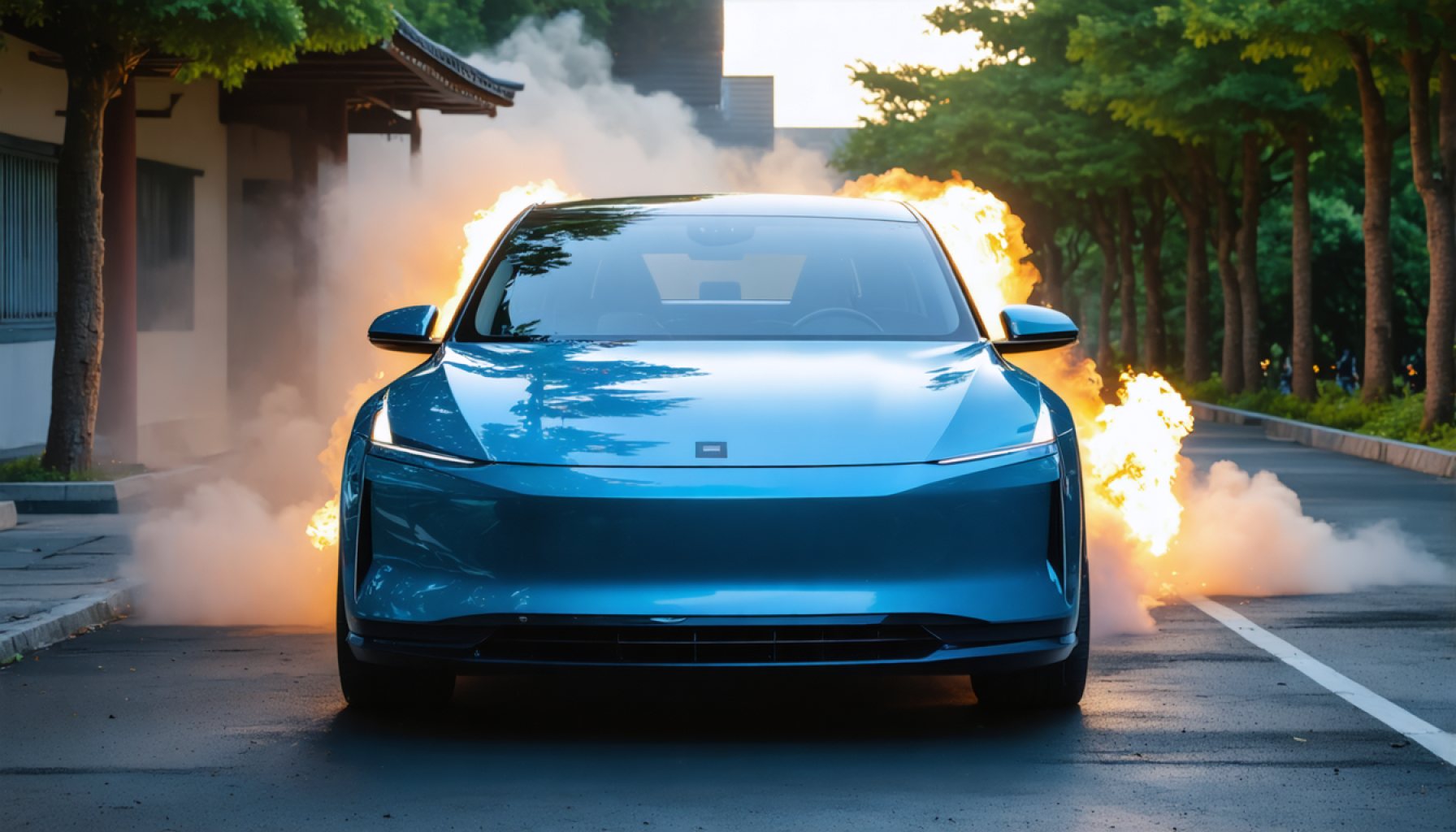- The incident involving a Xiaomi SU7 on the Dezhou-Shanghai Expressway has intensified concerns about electric vehicle (EV) battery safety.
- The Xiaomi SU7 features a 73.6-kWh lithium iron phosphate battery, utilizing cells from BYD and CATL, illustrating a shared focus on rigorous battery standards.
- Battery safety remains a critical issue; despite advanced protective measures, lithium-ion technology is susceptible to risks like thermal diffusion during high-impact events.
- Xiaomi’s innovative designs, such as “Battery Pack and Vehicle” technology, promise improved safety, but challenges persist in standard models.
- The need for enhanced safety measures grows as EV adoption increases, emphasizing innovation not just in performance, but in battery risk mitigation.
- The ongoing investigation seeks to pinpoint the cause of this particular fire, highlighting the delicate balance of EV safety and technological advancement.
A fiery scene erupted on the Dezhou-Shanghai Expressway—a Xiaomi SU7 Standard model collided with the central barrier and ignited, sending plumes of smoke into the crisp spring air. As first responders battled the flames, the incident fueled a sudden spike in attention toward the safety of electric vehicle batteries—a concern that refuses to smolder.
The SU7, Xiaomi’s latest foray into electrified transportation, packs a 73.6-kWh lithium iron phosphate battery with power cells sourced from industry stalwarts BYD and CATL. Despite rigorous standards in battery construction and a marketed endurance of 700 kilometers per charge, disaster struck—a stark reminder of the volatile nature of lithium-based technology.
As investigators delve into the charred evidence, a pressing question remains: what failed? Initial statements from CATL clarified that they only supplied battery cells which Xiaomi then assembled into battery packs. BYD similarly refrained from drawing premature conclusions, pending a comprehensive internal review by Xiaomi.
The mishap draws our focus to the broader landscape of electric car batteries. Modern EV batteries balance on a razor’s edge, their chemistry a cocktail of possibilities fraught with risk if mishandled. The lithium-ion variety, particularly vulnerable due to its inclusion of flammable solvents, often comprises the standard arsenal of EV power. Despite advances in safety—Xiaomi boasts 14 layers of physical protective structures and groundbreaking heat management techniques like “cell inversion”—electrical fires persist.
A stark explanation surfaces from an automotive engineering insider: violent impacts deform battery packs, potentially short-circuiting the cells and triggering catastrophic thermal diffusion. The current tech, while advanced, struggles to eradicate this Achilles’ heel completely; it merely reduces, not eliminates, the likelihood of thermal runaway scenarios.
Interestingly, Xiaomi’s patented “Battery Pack and Vehicle” technology, detailed in recent filings, hints at progress. The design features intricate cooling and thermal conduction innovations that promise enhanced safety during unpredictable road mishaps. Yet, the application of Xiaomi’s defensive “bulletproof coating” remains limited to their ultra models and absent in the beleaguered standard model.
Xiaomi’s co-founder and visionary, Lei Jun, utilizes dramatic demonstrations—a watermelon tossed from a factory’s upper floors to highlight the durability of racing innovations. Yet, even these robust protections prove insufficient against the unforeseen force of a highway collision.
The resonating takeaway here transcends a single vehicular incident: as the electric vehicle revolution unfolds, our commitment to innovation must parallel our dedication to safety. The age of battery stewardship requires fearless introspection and accelerated development in rooting out hazards before they manifest on bustling highways.
Explosive Insights: How Electric Vehicle Battery Incidents Are Shaping Future Safety Standards
Analyzing the Xiaomi SU7 Incident: Insights and Implications
The recent incident involving Xiaomi’s SU7 Standard model on the Dezhou-Shanghai Expressway has heightened concerns about the safety of electric vehicle (EV) batteries. As the investigation continues, and Xiaomi conducts an internal review to determine the cause, it’s essential to look beyond this single event to understand broader implications and forthcoming trends in EV technology.
Understanding the Current State of EV Battery Safety
1. Battery Chemistry Vulnerability: Lithium-ion batteries, a staple in electric vehicles, are known for their energy density but also come with the risk of thermal runaway—a condition where increased temperature leads to further reactions, potentially causing a fire. This is particularly concerning during collisions where batteries can be compromised.
2. Manufacturing and Assembly: While CATL and BYD supply the cells, Xiaomi’s role in assembling these into battery packs is under scrutiny. Proper assembly and thermal management are crucial in preventing battery failures.
3. Protection and Innovation: Xiaomi’s technologies like “cell inversion” and 14-layer protective structures showcase advancements aimed at mitigating risks. However, the lack of the “bulletproof coating” on standard models unveils discrepancies in safety features across product lines.
How-To Enhance EV Battery Safety:
– Regular Maintenance: Conduct regular checks on battery health and structural integrity, especially after minor collisions.
– Adopt Advanced Safety Features: When purchasing EVs, opt for models equipped with comprehensive safety technologies, even if they cost more.
– Stay Updated on Recalls and Safety Bulletins: Manufacturers often release updates or recalls that address newly discovered battery issues.
Real-World Use Cases and Industry Trends
– Extended Range and Efficiency: Despite this setback, EV manufacturers, including Xiaomi, strive to increase the range and efficiency of their models without compromising safety—an essential for gaining consumer trust.
– Collaboration with Cell Manufacturers: Firms like BYD and CATL are at the forefront of research, steering the development of next-gen batteries with reduced flammability and improved thermal management.
Insights and Predictions
– Rise of Solid-State Batteries: The automotive industry should expect a gradual shift towards solid-state batteries, which promise enhanced safety with non-flammable solid electrolytes.
– Improved Regulations and Standards: Future legislation may impose stricter safety standards which could drive innovation in battery management systems and vehicle architecture.
Pros and Cons Overview of EV Battery Technologies
Pros:
– High energy density and efficiency.
– Rapid advancements leading to improved safety measures.
Cons:
– Risk of fire in severe impacts.
– Current technology limits complete prevention of thermal runaways.
Actionable Recommendations
– For Consumers: When selecting an EV, prioritize models with the latest safety features, such as advanced thermal management systems and protective coatings.
– For Manufacturers: Invest in R&D focused on enhancing battery assembly processes and adopting best practices from cell suppliers like CATL and BYD.
For more insights on electric vehicles and safety standards, visit Xiaomi.
By scrutinizing the lessons learned from the Xiaomi SU7 incident, both consumers and manufacturers can advance further towards safer, more reliable electric vehicles.

















